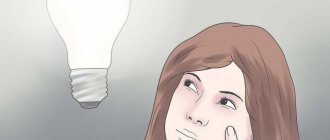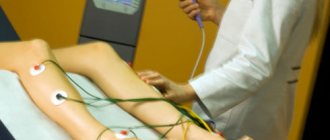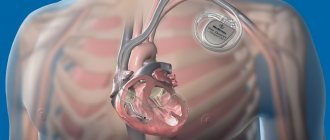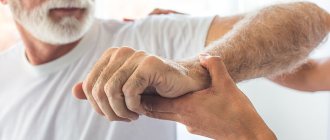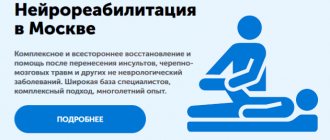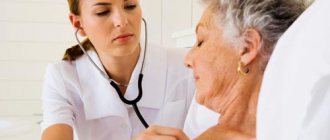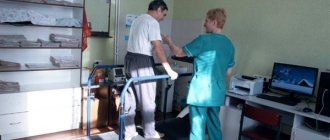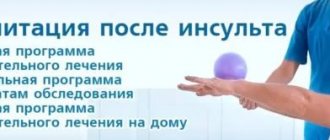Treatment
Treatment with coronary artery bypass grafting is carried out by a cardiologist. This operation is quite complex and requires serious skills and abilities. In addition, the procedure requires a lot of effort on the part of the patient, because the recovery stage lasts several months.
The recovery stage after any surgical intervention includes a whole range of procedures aimed at maintaining the vital functions of the body and stabilizing the human condition. To do this, the patient is given drug therapy, the main objective of which is to prevent inflammation and quickly restore cardiac activity.
Why do you need therapeutic exercises after bypass surgery? For a speedy recovery, as well as to improve the condition of the heart muscle in the postoperative period, proper and effective rehabilitation of the patient, which includes therapeutic breathing and exercise therapy, is of great importance.
Health-improving physical education after coronary artery bypass surgery allows you to:
- include in the work of all circulatory organs;
- gradually increase the load on the myocardium, so that the body gets used to it;
- ensure stable operation of all circulatory organs, including extracardiac ones - this can significantly reduce the load on the heart muscle;
- prevent the development of inflammatory processes in the chest;
- restore metabolic processes in the myocardium;
- produce a general strengthening of the muscular system of the heart for optimal myocardial contraction;
- reduce the number of complications after surgery;
- quickly restore the overall immunity and strength of the body.
In addition, therapeutic exercises after CABG can reduce the risk of developing thrombophlebitis of the veins of the lower extremities, infiltrates, promotes the healing of scars and the normal fusion of tissues damaged during surgery.
Diet during the recovery period after heart surgery
Typically, after open heart surgery, the patient suffers from a lack of appetite. Therefore, upon discharge, you most likely will not be prescribed any dietary restrictions. After one to two months, switch to a diet low in salt, sugar, and animal fats. Include in your diet foods high in fiber, vegetable oils, as well as iron-containing foods: buckwheat, red meat, liver, rose hips, pomegranate juice, etc. Eat more often, in small portions. Eat healthy food - this is your path to full recovery.
Training rules
Rehabilitation, including physical activities, after heart surgery are prescribed within a few days after the procedure. First, this process consists of simplified minimal physical tasks aimed at normalizing the patient’s proper breathing, as well as at fully restoring the body’s strength.
There are a number of rules required for the correct implementation of physical activities after coronary artery bypass surgery:
- any, even minimal exercises after surgery should be performed only after the advice of a specialist, who selects the complex individually for each patient, based on his condition and the complexity of the operation;
- the dosage of the load, as well as a set of tasks, is prescribed by the doctor, the training should take place under his supervision;
- classes should not be of a training nature and should not place a high load on the muscular system of the body;
- tasks should be performed in minimal quantities, gradually increasing the load on the body;
- performing health-improving physical education should be done regularly (exercises should be done periodically) for the most effective results;
- It is recommended to do gymnastics in the morning 20-30 minutes before meals or 1-2 hours before bedtime;
- when performing exercises, it is necessary to carefully and regularly monitor the patient’s pulse, blood pressure and heart rate;
- if even a minimal deterioration in the patient’s condition occurs, you should stop exercising and check the functioning of the body systems;
- Gymnastic movements should be carried out with parallel drug treatment and diet therapy prescribed by the attending physician.
Suture care after heart surgery
Before you are discharged, your doctor should tell you in detail how to care for the postoperative suture. Most patients are discharged after the sutures or staples are removed. Sometimes the stitches do not need to be removed; they dissolve on their own after a certain time. It is very important to carefully care for the stitch during the recovery period:
- The seam area must be dry and clean;
- You can wash the seam only with soap and water, and do not rub it under any circumstances;
- Do not lubricate the suture area with anything unless recommended by a doctor;
- Eat right, focusing on protein foods.
How to take water procedures after surgery
- If the postoperative suture heals, is dry and painless, you can take a warm shower for 10 minutes;
- If the post-operative suture looks painful, shower with your back to it;
- You can take a bath while sitting, but you must ensure that the water level does not reach the seam line;
- Water for water treatments should be warm, no contrast! Excessively hot or cold water may cause fainting;
- Wash the seam with ordinary soap, not shower gel. Do not rub the seam with a washcloth until the tissue is completely healed and the scabs disappear.
At the first signs of infection at the suture site (discharge, redness and swelling, body temperature above 38⁰C, elevated sugar in diabetics), consult a doctor immediately.
Contraindications
Physical education after any operation should be carried out in a particularly gentle manner, but, like all medical procedures, physical education has a number of contraindications that limit the circle of people allowed to perform tasks. The main contraindications for manipulations after coronary artery bypass grafting are:
- the first 3 days after the manipulation there is a high risk of suture divergence;
- serious condition of the patient;
- stable deterioration of the patient’s condition after several exercises;
- early complications that arose after the operation.
Carrying out physical therapy is possible only after eliminating malfunctions in the functioning of systems and organs.
Taking medications during the recovery period
When you leave the hospital after open heart surgery, your doctor will prescribe medications for you to take during the recovery period or for the rest of your life. Make sure you understand the name of the medications, dosage and mode of taking them correctly. Do not change the dosage or regimen at your own discretion. Any additional medications: cold medicines, painkillers, dietary supplements, herbal preparations should only be taken after consultation with your doctor. Ask your doctor how to take the medications you took before surgery.
Breathing exercises
This type of physical education is quite important in the healing process after surgery. Breathing exercises, as a type of health therapy, help normalize metabolic processes in the heart, which brings sufficient saturation of the blood with oxygen and leads to the fastest healing. In addition, therapeutic breathing movements stabilize the electrolytic balance of the heart and help normalize the rhythm.
Breathing exercises can be performed both in a supine position, when a person is in the early postoperative period, and in a standing position, in a later period.
The main tasks for performing breathing exercises after surgery include:
- close your right nostril with your finger, take a maximum inhalation through your left nostril, then close your left nostril and make a gradual, full exhalation through your right nostril; repeat the exercise in reverse order;
- if it is possible to raise your limbs: slowly raise both arms up, while taking a deep breath, then gradually lower your arms, quietly exhaling air; repeat the exercise 5-7 times;
- lying on your back, take a deep breath and hold your breath for a few seconds, then exhale slowly; repeat this task 5-7 times;
- lying on your back, legs straight, arms along the body; slowly take a deep breath and bend your legs at the knee joints, performing a sliding movement with your feet, then exhale deeply, at this time taking the original position of the torso; repeat the task 5-10 times.
If during breathing exercises the patient feels dizziness or nausea, or blurred vision, the exercise should be stopped. If the exercise goes well, then the set of exercises will help the heart return to normal quickly after surgery, as well as restore normal blood flow and oxygen exchange in the tissues.
Physical activity during recovery after heart surgery
In the first two months after open heart surgery, the following recommendations should be followed:
- The load must be increased gradually. You can do light housework: dusting, washing dishes, cooking while sitting. Do not stand in one place for more than 15 minutes;
- Do not lift anything weighing more than 5 kg (this load can be adjusted by your doctor). Do not push or pull anything heavy;
- Make sure that the loads on the shoulder girdle are symmetrical. For example, when getting up from the sofa, lean on both hands at once to avoid stress on the sternum;
- Try to avoid climbing stairs once again. If this cannot be avoided, stop to rest as often as possible, listen to your body;
- Take regular walks. First, start walking the same distances that you walked before discharge, 200-300 meters. Stop for a rest. By the second week of staying at home, increase the distance to 700 meters, in the third to 900 meters. By the end of the fourth week of staying at home, you can walk a distance of one kilometer, naturally with stops to rest. It is better to take a walk before eating;
- Try to get enough sleep. If you feel tired, lie down and rest. An afternoon nap is very important. For many patients, their sleep patterns are disrupted during the postoperative period; over time, everything will return to normal. There is no need to worry or take any medicine. If lack of sleep is bothering you, consult your doctor.
Physical exercise
Therapeutic gymnastics after bypass surgery is carried out both in the postoperative period, when the patient is in bed, and during the period of normalization of the body systems and restoration of the patient’s ability to get up.
An approximate set of exercises in a supine position:
Exercise therapy must be carried out in loose clothing that does not restrict breathing and movement. For best results, do 2-3 approaches throughout the day. Physical exercises should begin with the simplest tasks for the patient, gradually increasing the load as the muscles warm up.
- perform flexion and extension of the feet, 5-10 times for each leg;
- flexion and extension of the hands, 50-10 approaches for each;
- perform flexion and extension movements of the arms in the elbow joints, while touching the shoulders with the hands; perform 5-10 times.
- take a deep, slow breath in and out, raising your arms perpendicular to your body;
- bend your leg at the knee and then slowly lower it to its original position; repeat the exercise for the second leg. 5-10 reps.
- lying on your back, place your hands with your palms up, then take a slow breath and straighten your arms in different directions, simultaneously turning your feet outward, then return to the starting position, while exhaling deeply;
- move your legs bent at the knees randomly in different directions for 1-2 minutes;
- raise your hand and touch it to the leg bent at the knee, located on the same side of the body, then take the usual position; repeat the task for the second half of the body; quantity – 5-10 times for each half;
- lie down straight; As you inhale, stretch your arms in both directions, while turning your head to the right side, and as you exhale, return to the starting position. Next, complete the task by turning your head to the left; perform the movement 4-6 times;
- clench your hands into a fist and make quick circular movements with both hands for 30 seconds;
- bend your knees; carry out voluntary extension of the limbs at a free pace; execution time 30-60 seconds;
- tighten your gluteal muscles, then relax; repeat 5-10 times.
Exercises while sitting
These physical movements should be performed in parallel with breathing exercises. The lesson includes:
- Press your arms bent at the elbow joints to your shoulder, then smoothly spread your elbows in different directions, while taking a deep breath; gradually lowering your hands, exhale; repeat 5-10 times.
- Make circular movements with your arms, slowly raising and lowering them, perform the exercise for 30 seconds.
- Perform a circular movement of your arms, then hold your hands on your knees; make a gradual tilt of the torso towards the knees, then slowly take the starting position; repeat 4-5 times.
- Alternately raise your shoulders to your head, then lower them, do the exercise for 30 seconds.
- Gradually bend your leg and bring your knee to your chin, inhaling, then straighten it, exhaling; repeat 4-5 movements for each leg.
The main goal of therapeutic exercises is a targeted action on the restoration of the body. It is important to remember that all movements should be performed at a quiet pace and should not cause the patient a feeling of discomfort or heaviness. Only full and regular training with a gradual increase in load will have a positive effect and will contribute to adequate medical therapy.

